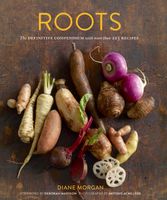Advertisement
Varieties
Appears in
By Diane Morgan
Published 2012
First, a clarification: Yuca (pronounced YOO-ka) is not to be confused with yucca (pronounced yuhk-uh), which is the common name for the many species of the genus Yucca. Members of the Asparagaceae family, yuccas thrive in warm regions, like yuca, and bear edible parts, including fruits, seeds, flowers, and flowering stems—but not the roots.
Now back to yuca. There are two primary varieties, bitter and sweet, distinguished by the level of the toxic glycoside linamarin present in the root. Have no fear: processing yuca through peeling, washing, boiling, roasting, toasting, or fermentation removes all toxicity. Sweet yuca, which is what we find in the marketplace as an unprocessed root, comes to the United States primarily from Costa Rica and the Dominican Republic. When cooked, it has a nuanced sweet taste and dry, mealy texture and can replace boiled potatoes in many dishes.

